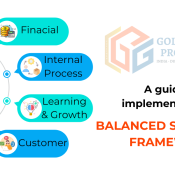
The Art Of Creating A Successful Annual Operating Plan
Is such a thing necessary? Maybe your company is great at carrying out business plans and keeps things moving forward while you keep an eye on results in real-time
Is that not the hope?
Let’s be honest, though. If you had faith in the annual operating planning approach you currently use, you wouldn’t be reading this post.
Now let’s get started and examine the detailed steps involved in creating your annual operational plan.
An Annual Operating Plan: What Is It?
An Annual Operating Plan (AOP) is a strategic roadmap that converts your company’s goals into doable tasks. It is a comprehensive road map that lists the strategic goals of your company, the yearly budget, the action plans, and the distribution of resources for a certain fiscal year.

An annual business plan, or AOP, gives you a bird’s-eye perspective on how to manage risks and distribute project resources so that you can focus on executing your top priorities. The plan acts as a link between overarching corporate objectives and routine business tasks.
What is the difference between a business strategy and an annual operating plan (AOP)? Business strategy outlines the choices you need to make for your organization to win. AOP involves budget allocation, timelines, and deliverables, empowering your team to execute your strategy successfully.
An Annual Operating Plan’s Advantages
When an annual operating plan is well aligned with an organization’s financial budget and strategic plan, the full benefits of the plan can be fully realised. Here’s how to do it:
Optimised use and efficiency of resources
An AOP guarantees that resources are allocated effectively to initiatives and projects that are in line with the financial plan and company strategy. Coordinating daily operations with long-term objectives minimises resource waste and helps you allocate human, financial, and other resources towards accomplishing strategic objectives.
Synchronisation and concentration on the most important business issues
An annual operational plan gives your team a clear path to a common vision and clarifies each member’s responsibility for achieving team goals. It creates a cohesive, goal-driven work atmosphere by encouraging cooperation and communication while removing silos.
Regulated implementation of a plan
You can quickly determine if the organisation is on track to meet its objectives by setting precise Key Performance Indicators (KPIs) and milestones in your AOP. These indicators will assist you in determining which areas need to change direction right away to maintain alignment with the overall plan.
Determined, and data-driven choices
An AOP that is well-rounded gives you information to aid in decision-making. These insights ensure that all team actions are outcome-focused by enabling proactive reactions to opportunities and obstacles.
How Can An Annual Operating Plan Be Made?
Here is a detailed instruction manual for you to follow:
Step 1: Conduct preliminary investigation and analysis
Start the planning process by evaluating your organisation as it stands right now. Examine the results from the prior year, taking into account information from several sources, such as operational and financial records.
You may make sure that your yearly operational plan for the following year is based on facts by doing a thorough company evaluation.
This aids in developing a comprehensive strategy that takes into account the requirements, advantages, and disadvantages of your company. It also lays the groundwork for eventual operational and financial planning, which will be discussed in more detail in the essay.
Step 2: Discuss requirements with important stakeholders
Your annual operating plan’s (AOP) efficacy depends on how well it reflects the overall objectives of your business. Without it, all you’re doing is drafting a series of plans that, if carried out, would probably not affect the overarching corporate strategy.
Talk about important business goals with the CFO and CEO to guarantee organisational alignment. To learn more about the requirements and goals of the department, consult with department leaders and other important stakeholders.
Their participation will assist you in establishing reasonable and doable goals and ensure their complete support when it comes time to implement the plan.
Step 3: Allocate funds and resources
Start by examining your revenue targets to determine the real amount of sales required to meet your goals.
Work with department leaders to determine what resources—such as labour, machinery, and other supplies—are available. Check to see if they are enough to achieve the goals you have set.
Make a list of all the costs you incurred, including those for labour, supplies, marketing, and new equipment. This exercise gives you a clear view of how much money you’ll need to set aside for certain tasks and initiatives to achieve the goals outlined in your annual plan.
Recommended Reading: The Operational Strategy: Making It Work For Your Organization (Part 1)
Step 4: Make a plan of action
You should specify your metrics in this phase and go beyond simple measurement. Establish specific goals. Next, make connections between these goals and the plans, projects, and activities that will help you reach those figures.
Make sure every department head writes important initiatives and action plans targeted at reaching their yearly objectives, regardless of whether your organisation has several departmental plans or a single, cohesive annual operating plan.
Remember to include both leading and lagging indicators in your KPI set-up to monitor success.
Step 5: Examine and give your approval
Make sure your AOP is comprehensive and takes into account the requirements of many stakeholders. To encourage cooperation and alignment, have the plan reviewed by several departments. Additionally, it guarantees that everyone agrees in the beginning.
Obtain support from decision-makers, like as executives or board members, following an internal assessment to achieve buy-in at the highest levels. Your annual plan will be easier to implement with this buy-in.
Step 6: Execute and monitor
Everyone engaged has to go to work on the projects they have been given. Make sure each team member understands that their responsibilities have a deadline and that they are responsible for finishing them.
Monitoring progress through the KPIs you set previously is essential to ensure you’re remaining on target. Staying on course throughout the year is ensured by tracking your progress against your objectives.
Recommended Reading: 6-Step Guide to Strategic Implementation
Tip: Make reviewing your annual operational plan a regular schedule. This might be done weekly, monthly, quarterly, or semi-annually, depending on your needs.
Annual Operating Plan FAQ
What should be included in an annual operating plan?
A well-structured annual operating plan should include:
- A clear set of strategic objectives
- Detailed action plans
- Performance metrics
- Resource allocation
- Risk mitigation plans
What is the difference between annual operating plans and budgets?
Annual operating plans and budgets are both financial planning tools used to manage performance. An AOP is a comprehensive blueprint that includes your overarching goals and the details to execute them, including the financial and human resources needed.
On the other hand, CFOs use budgets to focus mostly on the financial aspect of the organisation’s plan and are highly numbers-driven. They provide detailed projections of revenue, expenses, and cash flows but lack the strategic depth of AOPs. Unlike AOPs, they’re less flexible once approved and primarily intended for financial and accounting teams.



